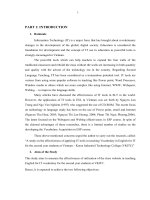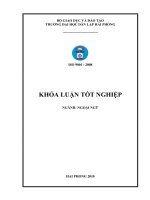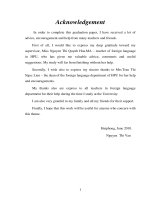A study on language of advertisements in foreign newspapers
Bạn đang xem bản rút gọn của tài liệu. Xem và tải ngay bản đầy đủ của tài liệu tại đây (2.67 MB, 73 trang )
1
Bộ giáo dục và đào tạo
tr-ờng đại học dân lập hải phòng
ISO 9001-2008
Khóa luận tốt nghiệp
ngành: NGOạI NGữ
Sinh viên : Dng Th Thoan
Ngi hng dn: Ths. Phm Th Bớch Ngc
(Yêu cầu ghi đầy đủ học hàm, học vị )
Hải phòng - 2009
2
Haiphong private university
Department of foreign languages
Graduation paper
A study on LANGUAGE OF ADVERTISEMENTS IN FOREIGN
NEWSPAPERS
By:
DUONG THI THOAN
Class:
NA904
Supervisor:
PHAM THI BICH NGOC, M.A
Hai phong - 2009
3
ACKNOWLEDGEMENTS
First of all, I would like to express my deepest gratitude to my supervisor, Mrs.
Pham Thi Bich Ngoc (M.A) who from the beginning to the end helped me to
finish this paper with valuable instructions and precious materials.
I would also like to show my special thanks to Mrs. Dang Thi Van (M.A) who
has always been most willing to give me precious suggestions and reference
books with generous patience and encouragement during the process of my
writing.
My sincere thanks also go to Mrs. Tran Thi Ngoc Lien (M.A) – the Dean of
English Department of Haiphong Private University and all other teachers who
whole-heartedly taught me for four years.
I am thankful to all my friends who help me to collect useful information and
necessary materials for the fulfillment of my paper.
Finally yet importantly, I would like to give my passionate thanks to my devoted
parents for their day-to-day sacrifice, support and encouragement during the
process of writing this paper.
I would not have been able to finish this paper so smoothly without the kind and
great help from the people mentioned above.
Haiphong, June 2008
Duong Thi Thoan
4
TABLE OF CONTENTS
Acknowledgement
PART ONE: INTRODUCTION .1
I. Rationale 1
II. Aims of the study 2
III. Scope of the study 2
IV. Method of the study 2
V. Design of the study 3
PART TWO: DEVELOPMENT 4
CHAPTER I: THEORETICAL BACKGROUND 4
1. English language 4
1.1. Definition of language 4
1.2. English language 5
1.2.1. What is English language? 5
1.2.2. History of English language 6
1.2.2.1. Indo-European and Germanic Influences 6
1.2.2.2. Old English (500-1100 AD) 7
1.2.2.3. The Norman Conquest and Middle English (1100-1500) 8
1.2.2.4. Early Modern English (1500-1800) 8
1.2.2.5. Late-Modern English (1800- Present) 9
1.2.2.6. American English 9
2. Advertisement 10
2.1. What is advertisement? 10
2.2. Types of advertisement 11
5
2.2.1. Print Advertising – Newspapers, Magazines, Brochures, Fliers 11
2.2.2. Outdoor Advertising – Billboards, Kiosks, Tradeshows and Events 11
2.2.3. Broadcast advertising – Television, Radio and the Interne 12
2.2.4. Covert Advertising – Advertising in Movies 12
2.2.5. Surrogate Advertising – Advertising Indirectly 13
2.2.6. Public Service Advertising – Advertising for Social Causes 13
2.2.7. Celebrity Advertising 13
2.3. Components of an advertisement 14
2.3.1. Artwork 14
2.3.2. Headline 15
2.3.3. Body 15
2.3.4. Contact 15
2.3.5. Extras 15
2.4. Advertisements in newspapers 15
CHAPTER II: LANGUAGE FEATURES OF ENGLISH
ADVERTISEMENTS IN FOREIGN NEWSPAPERS 18
1. Words and Phrases 18
1.1. Words 18
1.1.1. Choose the simple words 18
1.1.2. Used of emotive words 20
1.1.3. Used of weasel words 21
1.1.4. New Words Constantly appear 23
1.1.5. Excellent words used in advertisements 24
1.2. Phrases 26
1.2.1. Free offers 27
6
1.2.2. Charge offers 28
1.2.3. News 29
1.2.4. How to 30
1.2.5. Information 31
1.2.6. Confidence Building 32
1.2.7. Price 33
1.2.8. Miscellaneous phrases 34
1.2.9. Immediate Action 35
2. Parts of speech 36
2.1. Verbs 36
2.2. Adjective 41
2.3. Nouns 44
2.4. Pronouns 46
3. Sentence 48
3.1. Sentence structure 49
3.2. Sentence patterns 50
4. Tense and Voice 51
4.1. Tense 51
4.2. Voice 52
5. Pun and Repetition 53
5.1. Pun 53
5.2. Repetition54
6. Simile and Metaphor 55
6.1. Simile 55
6.2. Metaphor 55
Chapter III: IMPLICATION 56
1. Some problems in reading English advertisements in Foreign
7
Newspapers 56
1.1. New words 56
1.2. Special sentences 58
2. Some suggestions to overcome the problems 58
PART THREE: CONCLUSION 60
Reference 61
Part ONE: introduction
I. Rationale
Nowadays, English is the dominant international language in communications,
science, business, aviation, entertainment, radio and diplomacy. In order to learn
the world, we need to learn English. Reading English newspapers everyday is a
very good way to improve our English because newspapers play an important
role in distributing news and general information. By the time we read a
newspaper, we have already learned about breaking news stories on television or
radio. We rely on newspapers to provide detailed background information and
analysis, which television and radio newscasts rarely offer. Newspapers not only
inform an event happened but also help us understand what led up to the event
and how it will affect the world around us.
Because language develops together with society, being a good reader is
a key to the door of success indeed in the era of science and technology. I have
always been attracted to advertisement when reading newspapers by its lively
images and its language features as well. Do you feel able to fully understand an
advertisement message? Not as classroom situation, reading advertisements in
daily newspapers – reading in the real world - supplies us all information to
choose the best goods. We cannot count troubles due to not reading
advertisements carefully before purchasing. Advertisement is a language, this
8
means that we have to study it in order to practice it and, first of all, to
understand it. Language in advertisements is of crucial importance because it is
the main carrier of the message all along. It distinguishes itself from common
language by its own features. However, most of English learners have
difficulties in reading advertisements in foreign newspapers due to complex
grammar, lexicology, the use of language of native speakers, etc. Therefore, I
conducted this study with the hope that it could help learners have a deep
knowledge of English used in advertisements and could understand
advertisements exactly.
II. Aims of the study
My study aims at:
- Introducing theoretical background of language, advertisement and
newspaper.
- Giving an analysis of language used in English advertisement in
newspapers.
- Pointing out some difficulties, common mistakes possibly made by
Vietnamese learners and suggesting some solutions to avoid misunderstanding
when reading advertisement in foreign newspapers.
III. Scope of the study
English language of advertisement in foreign newspapers is extremely large of
the study. Due to the limitation of time, knowledge, and experience, I am not
ambitious to study all matters but focus on features of words, phrases, parts of
speech, sentence, tense, voice, pun and alliteration of advertising language.
Particularly, I pay much attention to language of daily consumer goods
advertisements, technical equipment advertisements and service advertisements
in some famous newspapers such as Equipment News, The New York Times,
Newsweek (issues from 2008-2009), and in some online newspapers:
9
IV. Method of the study
In order to achieve the mentioned aims, in my study process, I store knowledge
from a lot different kinds of resources specialized as following:
- Referencing different books and websites on language, advertisement to
establish the theoretical background for the paper,
- Collecting and analyzing number of advertisement in foreign
newspapers,
V. Design of the study
My graduation paper is divided into three main parts of which the second one is
the most important part.
- Part one gives out the rationale, the aims, the scope, the methods, and
the design of the study.
- Part two mentions the main content of the study and it is further divided
into 3 chapters as below:
Chapter I: Theoretical background - introduces definition and some
characteristics of English language and advertisement.
Chapter II: Language features of English advertisement in Foreign
Newspapers - analyses some features of words, phrases, parts of speech,
sentence, tense, voice, pun, repetition, simile and metaphor of English
advertising language.
Chapter III: Implication - points out some problems in reading English
advertisement process and gives some suggestions to overcome the problems.
- Part three gives a brief summary of the main points mentioned in the
10
previous parts and some suggestions for further study.
11
PART TWO: DEVELOPMENT
CHAPTER I. THEORETICAL BACKGROUND
1. English language
1.1. Definition of language
Lyons, J (1981:3) states five definitions of language as follows:
(i) According to Sapir (1921: 8): “Language is a purely human and non-
instinctive method of communicating ideas, emotions and desires by means of
voluntarily produced symbols.”
(ii) Bloch & Trager (1942:5): “A language is a system of arbitrary vocal
symbols by means of which a social group co-operates.”
(iii) Hall (1968:158) tells us that language is “the institution whereby
humans communicate and interact with each by means of habitually used oral-
auditory arbitrary symbols”.
(iv) Robins (1979:9-14) does not give a formal definition of language: he
rightly points out that such definition “tend to be trivial and uninformative,
unless they presuppose some general theory of language and of linguistic
analysis”. However, he does list and discuss a number of salient facts that “must
be taken into account in any seriously intended theory of language”. Throughout
successive editions of this standard textbook, he notes that languages are
“symbol systems almost wholly based on pure or arbitrary convention”, but lays
special emphasis on their flexibility and adaptability.
(v) The last definition to be quoted here strikes a very different note: “From
now on I will consider a language to be a set (finite or infinite) of sentences,
each finite in length and constructed out of a finite set of elements.” This
definition is taken from Chomsky‟s Syntactic Structures (1957:13), whose
publication inaugurated the movement known as transformational grammar.
The five definitions of „language‟ quoted and briefly discussed above have
served to introduce some of the properties, which some linguists have taken to
12
be essential features of languages, as we know them. Most of them have taken
the view that languages are systems of symbols designed, as it were, for the
purpose of communication.
Types of language (
Formal - Language used for a professional feel such as in a business
letter.
Informal - Language used in an everyday situation, which may include
slang.
Slang - Used in general conversation and not found in the dictionary.
Informative - Gives the reader specific information such as facts and
figures.
Descriptive - Uses many adjectives to help explain what is being spoken
about.
Emotive - Uses many adjectives to explain a person's feelings.
Dialogue - Text that is being spoken.
Emphasizing - Drawing attention to a particular point
Persuasive - Trying to force a particular point of view on someone
Imperative - Gives the reader instructions and orders.
1.1. English language
1.1.1. What is English language?
(
“English is a West Germanic language that originated in Anglo-Saxon England.
As a result of the military, economic, scientific, political and cultural influence
of the British Empire during the 18th, 19th and 20th centuries and of the United
States since the late 19th century, it has become the vehicular language in many
parts of the world. English is used extensively as a second language and as an
official language in Commonwealth countries and many international
organizations.”
Approximately 375 million people speak English as their first language.
13
English today is probably the third largest language by number of native
speakers, after Mandarin Chinese and Spanish. However, when combining
native and non-native speakers it is probably the most commonly spoken
language in the world, though possibly second to a combination of the Chinese
languages (depending on whether or not distinctions in the latter are classified as
"languages" or "dialects"). Estimates that include second language speakers vary
greatly from 470 million to over a billion depending on how literacy or mastery
is defined and measured. Linguistics professor David Crystal calculates that
non-native speakers now outnumber native speakers by a ratio of three to one.
The countries with the highest populations of native English speakers are,
in descending order: United States (215 million), United Kingdom (61million),
Canada (18.2 million), Australia (15.5 million), Ireland (3.8 million), South
Africa (3.7 million), and New Zealand (3.0-3.7 million). Countries such as
Jamaica and Nigeria also have millions of native speakers of dialect continual
ranging from an English-based Creole to a more standard version of English. Of
those nations where English is spoken as a second language, India has the most
such speakers ('Indian English'). Crystal claims that, combining native and non-
native speakers, India now has more people who speak or understand English than
any other country in the world. Following India is the People's Republic of China.
Books, magazines, and newspapers written in English are available in
many countries around the world. English is also the most commonly used
language in the sciences. In 1997, the Science Citation Index reported that 95%
of its articles were written in English, even though only half of them came from
authors in English-speaking countries.
1.1.2. History of English language
Dave Wilton, Monday, January 15, 2001:
1.1.2.1. Indo-European and Germanic Influences
English is a member of the Indo-European family of languages. This
broad family includes most of the European languages spoken today. The Indo-
14
European family includes several major branches:
Latin and the modern Romance languages;
The Germanic languages;
The Indo-Iranian languages, including Hindi and Sanskrit;
The Slavic languages;
The Baltic languages of Latvian and Lithuanian (but not Estonian);
The Celtic languages;
Greek.
The influence of the original Indo-European language, designated proto-
Indo-European, can be seen today, even though no written record of it exists.
The word for father, for example, is vater in German, pater in Latin, and pitr in
Sanskrit. These words are all cognates, similar words in different languages that
share the same root.
Of these branches of the Indo-European family, two are, for our purposes
of studying the development of English, of paramount importance, the Germanic
and the Romance (called that because the Romance languages derive from Latin,
the language of ancient Rome, not because of any bodice-ripping literary genre).
English is in the Germanic group of languages. This group began as a common
language in the Elbe river region about 3,000 years ago.
1.1.2.2. Old English (500-1100 AD)
West Germanic invaders from Jutland and southern Denmark: the Angles
(whose name is the source of the words England and English), Saxons, and
Jutes, began populating the British Isles in the fifth and sixth centuries AD.
They spoke a mutually intelligible language, similar to modern Frisian-the
language of northeastern region of the Netherlands-that is called Old English.
Four major dialects of Old English emerged, Northumbrian in the north of
England, Mercian in the Midlands, West Saxon in the south and west, and
Kentish in the Southeast.
The majority of words in modern English come from foreign, not Old
15
English roots. In fact, only about one sixth of the known Old English words
have descendants surviving today. However, this statistic is deceptive; Old
English is much more important than this number would indicate. About half of
the most commonly used words in modern English have Old English roots.
Words like be, water, and strong, for example, derive from Old English roots.
Old English, whose best-known surviving example is the poem Beowulf,
lasted until about 1100. This last date is rather arbitrary, but most scholars
choose it because it is shortly after the most important event in the development
of the English language, the Norman Conquest.
1.1.2.3. The Norman Conquest and Middle English (1100-1500)
William the Conqueror, the Duke of Normandy, invaded and conquered
England and the Anglo-Saxons in 1066 AD. The new overlords spoke a dialect
of Old French known as Anglo-Norman. The Normans were also of Germanic
stock (Norman comes from Norseman) and Anglo-Norman was a French dialect
that had considerable Germanic influences in addition to the basic Latin roots.
The influence of the Normans can be illustrated by looking at two words,
beef and cow. Beef, commonly eaten by the aristocracy, derives from the Anglo-
Norman, while the Anglo-Saxon commoners, who tended the cattle, retained the
Germanic cow. Many legal terms, such as indict, jury, and verdict have Anglo-
Norman roots because the Normans ran the courts. This split, where words
commonly used by the aristocracy have Romantic roots and words frequently
used by the Anglo-Saxon commoners have Germanic roots, can be seen in many
instances.
By 1362, the linguistic division between the nobility and the commoners
was largely over. In that year, the Statute of Pleading was adopted, which made
English the language of the courts and it began to be used in Parliament.
The Middle English period came to a close around 1500 AD with the rise of
Modern English.
1.1.2.4. Early Modern English (1500-1800)
16
The first major factor influenced the language and served to separate
Middle and Modern English was the Great Vowel Shift. This was a change in
pronunciation that began around 1400. While modern English speakers can read
Chaucer with some difficulty, Chaucer‟s pronunciation would have been
completely unintelligible to the modern era. Shakespeare, on the other hand,
would be accented, but understandable. Long vowel sounds began to be made
higher in the mouth and the letter e at the end of words became silent. Chaucer‟s
Lyf (pronounced /leef/) became the modern word life. In Middle English name
was pronounced /nam-a/, five was pronounced /feef/, and down was pronounced
/doon/. In linguistic terms, the shift was rather sudden, the major changes
occurring within a century. The shift is still not over; however, vowel sounds are
still shortening, although the change has become considerably more gradual.
The other major factor in the development of Modern English was the
advent of the printing press. William Caxton brought the printing press to
England in 1476. Books became cheaper and as a result, literacy became more
common. Publishing for the masses became a profitable enterprise, and works in
English, as opposed to Latin, became more common. Finally, the printing press
brought standardization to English. The dialect of London, where most
publishing houses were located, became the standard. Spelling and grammar
became fixed, and the first English dictionary was published in 1604.
1.1.2.5. Late-Modern English (1800-Present)
The principal distinction between early- and late-modern English is
vocabulary. Pronunciation, grammar, and spelling are largely the same, but
Late-Modern English has many more words. These words are the result of two
historical factors. The first is the Industrial Revolution and the rise of the
technological society. This necessitated new words for things and ideas that had
not previously existed. The second was the British Empire. At its height, Britain
ruled one quarter of the earth‟s surface and English adopted many foreign words
and made them its own.
17
1.1.2.6. American English
Also significant beginning around 1600 AD was the English colonization
of North America and the subsequent creation of a distinct American dialect.
Some pronunciations and usages “froze” when they reached the American shore.
In certain respects, American English is closer to the English of Shakespeare
than modern British English is. Some Americanisms that the British decry are
actually originally British expressions that were preserved in the colonies while
lost at home (e.g., fall as a synonym for autumn, trash for rubbish, frame-up that
was reintroduced to Britain through Hollywood gangster movies and use of loan
as a verb instead of lend).
2. Advertisement
2.1. What is advertisement?
(Newsweek)
Advertising is a form of communication that typically attempts to persuade
potential customers to purchase or to consume more of a particular brand of
product or service. (
“While now central to the contemporary global economy and the
reproduction of global production networks, it is only quite recently that
advertising has been more than a marginal influence on patterns of sales and
production. The formation of modern advertising was intimately bound up with
18
the emergence of new forms of monopoly capitalism around the end of the 19th
and beginning of the 20th century as one element in corporate strategies to
create, organize and where possible control markets, especially for mass
produced consumer goods. Mass production necessitated mass consumption, and
this in turn required a certain homogenization of consumer tastes for final
products. At its limit, this involved seeking to create „world cultural
convergence‟, to homogenize consumer tastes and engineer a „convergence of
lifestyle, culture and behaviors among consumer segments across the world‟.
( Retrieved on 2009-04-20)
Money spent on advertising has increased dramatically in recent years. In
2007, spending on advertising has been estimated at over $150 billion in the
United States ( Retrieved on 2009-
04-20). And $385 billion worldwide,
( Retrieved on 2009-04-20) and
the latter to exceed $450 billion by 2010.
2.2. Types of advertisement
(
2.2.1. Print Advertising – Newspapers, Magazines, Brochures, Fliers
The print media have always been a popular advertising medium.
Advertising products via newspapers or magazines is a common practice. In
addition to this, the print media also offers options like promotional brochures
and fliers for advertising purposes. Often the newspapers and the magazines sell
the advertising space according to the area occupied by the advertisement, the
position of the advertisement (front page/middle page), as well as the readership
of the publications. For instance, an advertisement in a relatively new and less
popular newspaper would cost far less than placing an advertisement in a
popular newspaper with a high readership. The price of print advertisements also
depend on the supplement in which they appear, for example an advertisement
in the glossy supplement costs way higher than that in the newspaper
19
supplement which uses a mediocre quality paper.
In this chapter, part 2.2 and 2.4 will analyses more clearly about
components and characteristics of advertisement in newspapers.
2.2.2. Outdoor - Advertising – Billboards, Kiosks, Tradeshows and Events
Outdoor advertising is also a very popular form of advertising, which
makes use of several tools and techniques to attract the customers outdoors. The
most common examples of outdoor advertising are billboards, kiosks, and
several events and tradeshows organized by the company. The billboard
advertising is very popular however has to be really terse and catchy in order to
grab the attention of the passersby. The kiosks not only provide an easy outlet
for the company products but also make an effective advertising tool to promote
the company‟s products. Organizing several events or sponsoring those makes
for an excellent advertising opportunity. The company can organize trade fairs,
or even exhibitions for advertising their products. If not this, the company can
organize several events that are closely associated with their field. For instance,
a company that manufactures sports utilities can sponsor a sports tournament to
advertise its products.
2.2.3. Broadcast advertising – Television, Radio and the Internet
Broadcast advertising is a very popular advertising medium that
constitutes of several branches like television, radio or the Internet. Television
advertisements have been very popular ever since they have been introduced.
The cost of television advertising often depends on the duration of the
advertisement, the time of broadcast (prime time/peak time), and of course the
popularity of the television channel on which the advertisement is going to be
broadcasted. The radio might have lost its charm owing to the new age media
however; the radio remains to be the choice of small-scale advertisers. The radio
jingles have been very popular advertising media and have a large impact on the
audience, which is evident in the fact that many people still remember and enjoy
the popular radio jingles.
20
2.2.4. Covert Advertising – Advertising in Movies
Covert advertising is a unique kind of advertising in which a product or a
particular brand is incorporated in some entertainment and media channels like
movies, television shows or even sports. There is no commercial in the
entertainment but the brand or the product is subtly (or sometimes evidently)
showcased in the entertainment show. Some of the famous examples for this sort
of advertising have to be the appearance of brand Nokia which is displayed on
Tom Cruise‟s phone in the movie Minority Report, or the use of Cadillac cars in
the movie Matrix Reloaded.
2.2.5. Surrogate Advertising – Advertising Indirectly
Surrogate advertising is prominently seen in cases where advertising a
particular product is banned by law. Advertisement for products like cigarettes
or alcohol which are injurious to heath are prohibited by law in several countries
and hence these companies have to come up with several other products that
might have the same brand name and indirectly remind people of the cigarettes
or beer bottles of the same brand. Common examples include Fosters and
Kingfisher beer brands, which are often seen to promote their brand with the
help of surrogate advertising.
2.2.6. Public Service Advertising – Advertising for Social Causes
Public service advertising is a technique that makes use of advertising as
an effective communication medium to convey socially relevant messaged about
important matters and social welfare causes like AIDS, energy conservation,
political integrity, deforestation, illiteracy, poverty and so on. David Oglivy who
is considered to be one of the pioneers of advertising and marketing concepts
had reportedly encouraged the use of advertising field for a social cause. Oglivy
once said, "Advertising justifies its existence when used in the public interest - it
is much too powerful a tool to use solely for commercial purposes." Today
public service advertising has been increasingly used in a non-commercial
fashion in several countries across the world in order to promote various social
21
causes. In USA, the radio and television stations are granted on the basis of a
fixed amount of Public service advertisements aired by the channel.
2.2.7. Celebrity Advertising
Although the audience is getting smarter and smarter and the modern day
consumer getting immune to the exaggerated claims made in a majority of
advertisements, there exist a section of advertisers that still bank upon celebrities
and their popularity for advertising their products. Using celebrities for
advertising involves signing up celebrities for advertising campaigns, which
consist of all sorts of advertising including, television advertisements or even
print advertisements.
2.3. Components of an advertisement in newspapers
(
A complete advertisement consists of five parts:
22
(People)
2.3.1. Artwork
Photographs, drawings, and graphic embellishments are a key visual
element of many types of advertisements. Some advertisements may have only a
single visual while others might have several pictures. Even text-only
advertisements might have some graphics in the form of decorative bullets or
borders. When included with visuals the caption is one of the first things most
readers look at after the visual. It is not in all advertisements.
2.3.2. Headline
23
The title or main headline may be the strongest element of the
advertisement or it may be secondary to a strong visual. Some advertisements
may have subheads and other title elements as well.
2.3.3. Body
The body or copy is the main text of the advertisements. Some
advertisements may take a minimalist approach, a line, two, or a single
paragraph. Other advertisements may be quite text-heavy with paragraphs of
information, possibly arranged in columns newspaper style. While the words are
the most important part of the copy, visual elements such as indentation, pull-
quotes, bullet lists, and creative kerning and tracking can help to organize and
emphasize the message of the body of the advertisements.
2.3.4. Contact
The contact or signature of an advertisement may appear anywhere in the
advertisement although it is usually near the bottom. It consists of one or more of:
Logo
Advertiser Name
Address
Phone Number
Map or Driving Directions
Web Site Address
2.3.5. Extras
Some print advertisements may have additional special elements such as an
attached business reply envelope, tear-out portion with a coupon, tip sheet and
product sample.
2.4. Advertisements in newspapers
(
Newspaper, publication usually issued on a daily or weekly basis, the main
function of which is to report news. Many newspapers also furnish special
information to readers, such as weather reports, television schedules, and listings
24
of stock prices. They provide commentary on politics, economics, and arts and
culture, and sometimes include entertainment features, such as comics and
crossword puzzles. In nearly all cases and in varying degrees, newspapers
depend on commercial advertising for their income.
www.usa.canon.com
While newspapers lack the intrusiveness of radio and television, they are still an
effective advertising medium. They do an excellent job of reaching established
customers, and therefore, are an excellent base for retail advertising. There are
well over 9000 Newspapers in Canada and the United States and they
collectively comprise the largest advertisement medium. Over two thirds of the
dollars spent in Newspaper advertising is derived from local advertisers.
There are a number of characteristics of newspapers that make them
especially appealing to advertisers:
Most newspapers, both daily and weekly, reach the majority of homes in
their primary city or town.
Newspapers permit an advertiser to reach a large number of people within
a specified geographical area.
25
The printed advertising message has both permanence and desired
obsolescence. A reader can refer back to, or even clip and save, a particular
advertisement, yet tomorrow‟s edition is new, fresh, and as eagerly sought by
the same reader.
The newspaper offers a predictable frequency of publication: once, twice
or up to seven times a week.
Newspapers have immediacy. You can place an advertisement on
Monday and be getting results before the week is over. Short deadlines permit
quick responses to changing market conditions.
People expect to find advertising in their newspapers. In fact, many
people buy newspapers just to read the advertisements from the restaurants,
movies and discount stores.
Reading the newspaper has become a habit for most families. It has
something for everyone.
You can reach certain segments of your market by placing your
advertisements in different sections of the paper such as: sports, comics,
crosswords, news, classifieds, etc.
An advertiser has flexibility in terms of advertisement size and placement.
Production changes can be made quickly, if necessary, a new insert can be
added on short notice.
Advertisements can be examined at leisure. Exposure is not limited, so
readers can take their time reading the messages.
It offers a great variety of advertisement sizes. If you do not have a large
budget, you can still run a series of small advertisements.
Many options are available. Copy alone; copy with graphics; black and
white; or full color.
Newspaper supplements often feature certain subjects that readers pull out
and save.









